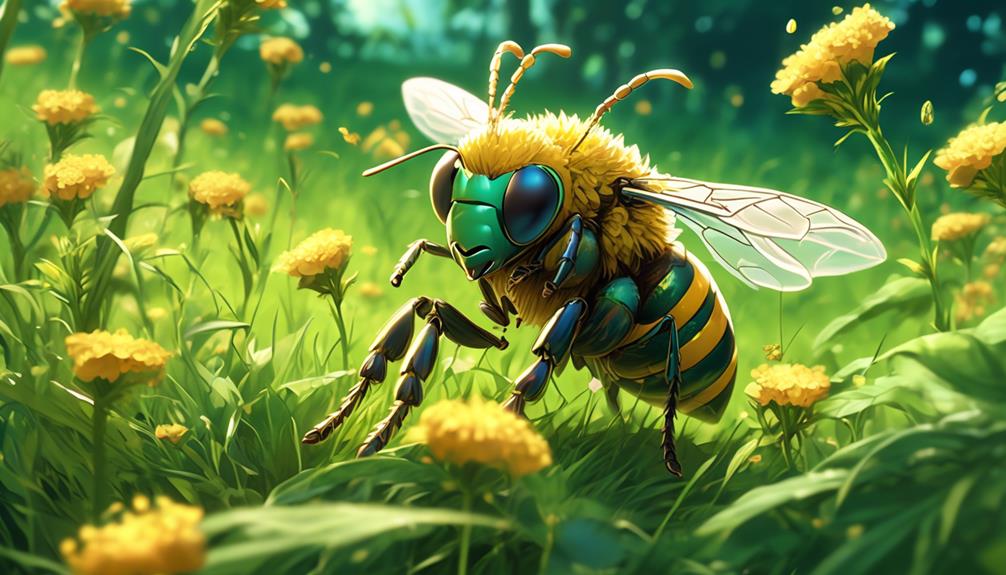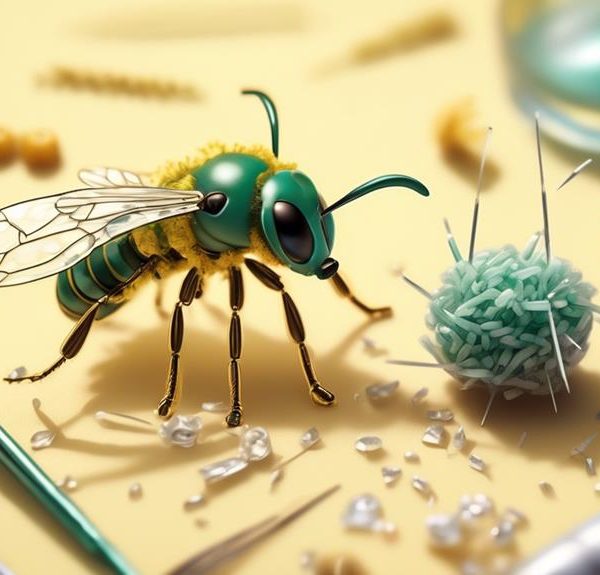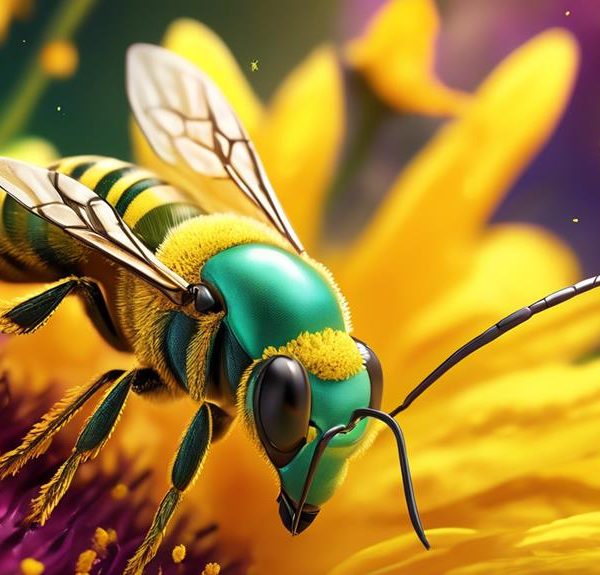Pondering over sweat bees' social or solitary lifestyles? Delve into their fascinating world and uncover the environmental factors that influence their behaviors.

Are Sweat Bees Solitary
Have you ever wondered about the social patterns of the humble sweat bee, whether they prefer to live in solitude or surrounded by a buzzing community? Well, you're not alone in this curiosity.
As you delve into the fascinating world of these tiny creatures, you'll discover that sweat bees, like people, can lean towards either solitary or social lifestyles. But how do they decide, and what factors influence this decision?
To truly understand, you'll need to explore further into their intriguing behaviors and the environmental factors that shape their existence.
Key Takeaways
- Sweat bees exhibit a mix of solitary and communal lifestyles, with some species being solitary and constructing their own nests, while others form simple communal nests or have complex social structures with a dominant queen and workers.
- Not all sweat bees live in colonies, as some prefer solitary lifestyles and assume all parental responsibilities.
- Some species of sweat bees display both solitary and social behaviors, switching between the two depending on environmental conditions.
- The environment plays a significant role in determining whether sweat bees choose solitary or social lifestyles, with warmer regions often having more social sweat bees and cooler regions having more solitary bees.
Understanding Sweat Bees

You might be surprised to learn that there are nearly 1,000 species of sweat bees in the U.S. alone. These tiny creatures, often mistaken for wasps, play a crucial role in pollination. Unlike honey bees, they're not aggressive unless provoked, so you don't need to break a sweat worrying about them.
Sweat bees get their unique name from their attraction to human perspiration. They're not after your workout glow, though. They're drawn to the salts and electrolytes in your sweat. Don't worry, their sting is mild, barely more than a mosquito bite.
You can spot these bees by their size and colors. They're smaller than honey bees, and their bodies can range from metallic green to black. They're solitary creatures, meaning each female bee tends to her own nest. However, some species do have a sort of social structure with a dominant queen bee.
Sweat bees remind us that not all bees live in hives or produce honey. They're a key part of our ecosystem, pollinating many plants that other bees can't reach. So next time you see one, don't swat it away. Let it do its important work.
Sweat Bee Species Overview

Diving into the world of sweat bees, it's fascinating to note the diversity among the nearly 1,000 species found in the U.S. alone. You'll find these species across every state, each with unique traits and behaviors. They vary in color, from metallic blues and greens to simple blacks and browns. Size, too, is diverse, with some species as small as a grain of rice and others up to half an inch long.
The most common species you might encounter is the Halictus rubicundus or the 'common sweat bee'. You'll recognize it by the distinctive bronze-like sheen on its body. It's known for its gentle nature, and like most sweat bees, it's attracted to human sweat, hence the name.
There's also the Lasioglossum, or 'small sweat bees', characterized by their smaller size and metallic bodies. They're found in various habitats, from woods to urban gardens.
Social Behavior of Sweat Bees

When it comes to their social behavior, sweat bees exhibit a fascinating mix of solitary and communal lifestyles. You'll find that some species are solitary, meaning each female constructs and provisions her own nest. She doesn't rely on any help from others.
On the other hand, many sweat bee species show varying degrees of sociality. You might observe that some sweat bees form simple communal nests, where females live together but each operates independently. It's like a bee version of roommates sharing an apartment, with each bee responsible for her own brood.
Then there are sweat bees that display more complex social structures, similar to honeybees. In these colonies, a dominant queen bee lays all the eggs and the other bees serve as workers. It's a full-blown insect society, with division of labor and cooperative brood care.
Solitary Vs. Social Sweat Bees

Drawing from the understanding of the varying social behaviors of sweat bees, it's worth delving deeper into the differences between solitary and social sweat bees. You see, not all sweat bees live in colonies. Some prefer to go it alone, hence the term 'solitary.' These loners lay their eggs in individual nests and assume all parental responsibilities. They're the jack-of-all-trades, managing food gathering, nest building, and offspring rearing all by themselves.
On the other hand, you've got social sweat bees. These bees live in colonies, where roles are typically divided. Workers gather food and care for the young, while the queen lays eggs. It's a system of division of labor, offering efficiency but requiring a degree of cooperation and coordination.
It's fascinating to note, though, that sweat bees aren't strictly one or the other. Some species display both behaviors, switching from solitary to social depending on environmental conditions. This flexibility is part of what makes sweat bees such an intriguing study.
Impact of Environment on Sweat Bees

The environment's influence on sweat bees is undeniable, affecting their behavior, reproduction, and even their choice to live as solitary or social creatures. These bees are quite adaptable, able to thrive in various habitats, from forests to deserts, and even in your backyard garden.
Climate, especially, plays a significant role. Warmer regions typically see sweat bees living socially in colonies, while those in cooler areas often lead solitary lives. It's a fascinating survival strategy, really. By living socially, bees can protect each other from predators and share resources, which is particularly advantageous in harsh, hot environments.
But that's not all. The availability of food sources and nesting sites in their environment also greatly influences sweat bees' social structure. In places where resources are plentiful, you'll find more social sweat bees. But in areas where they're scarce, bees tend to be solitary, reducing competition.
In short, it's the environment that often determines whether sweat bees choose to live alone or in a buzzing community. So, next time you spot a sweat bee, remember that their lifestyle isn't just a simple choice – it's a complex decision influenced by their surroundings.
Conclusion
So, are sweat bees solitary? Not all of them! Some species prefer living together, while others are loners. Your environment plays a crucial role in their behavior too.
Remember, these tiny creatures aren't just buzzing around your sweat; they're part of our ecosystem.
So, next time you encounter a sweat bee, appreciate its uniqueness and remember, it's just doing its part in maintaining the balance of nature.



